2022 HYUNDAI SONATA warning
[x] Cancel search: warningPage 515 of 546
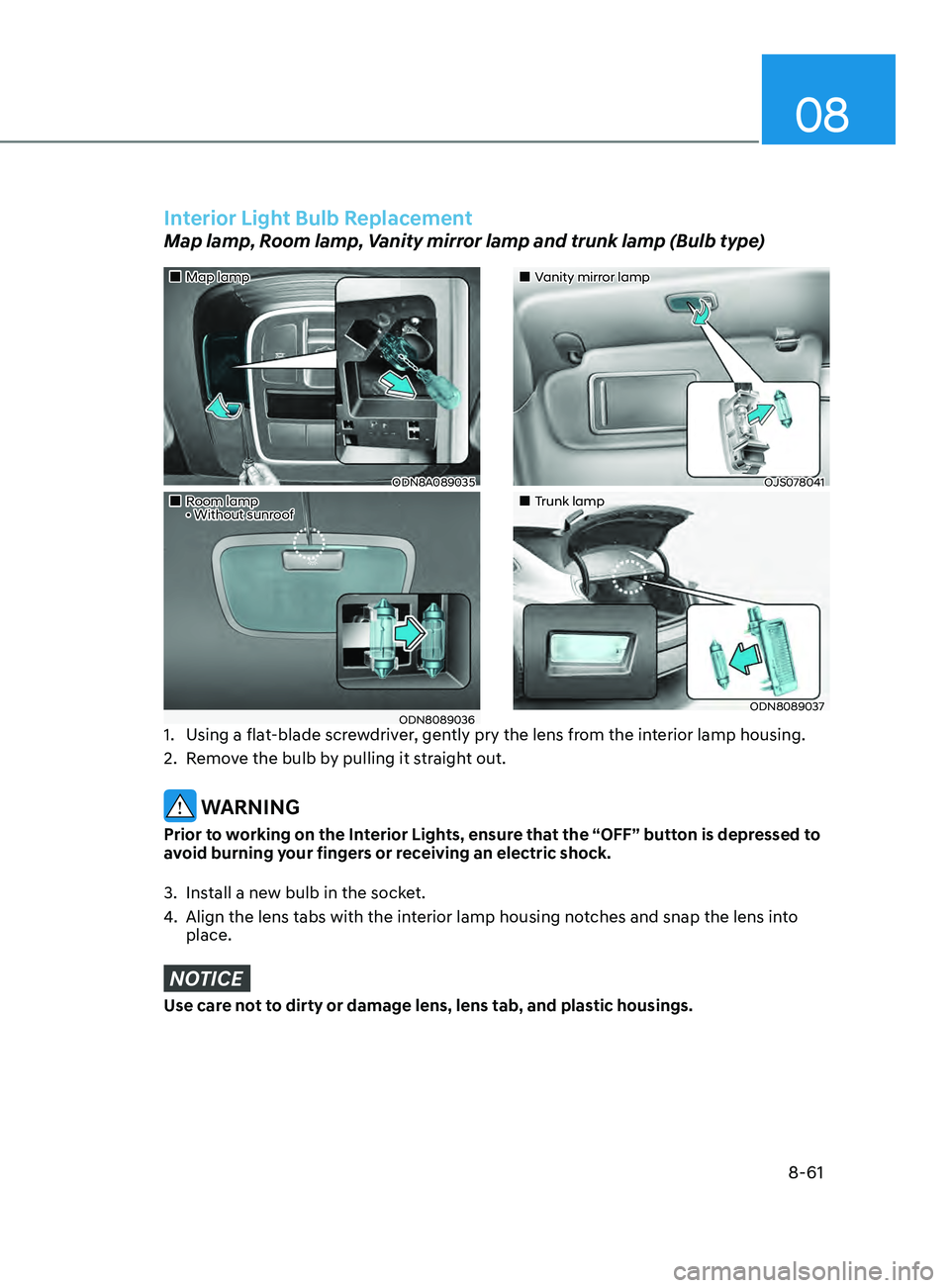
08
8-61
„„Map lamp
ODN8A089035
„„Room lamp • Without sunroof
ODN8089036
„„Vanity mirror lamp
OJS078041
„„Trunk lamp
ODN8089037
Interior Light Bulb Replacement
Map lamp, Room lamp, Vanity mirror lamp and trunk lamp (Bulb type)
1. Using a flat-blade screwdriver, gently pry the lens from the interior lamp housing.
2.
R
emove the bulb by pulling it straight out.
WARNING
Prior to working on the Interior Lights, ensure that the “OFF” button is depressed to
avoid burning your fingers or receiving an electric shock.
3.
Ins
tall a new bulb in the socket.
4.
Align the lens tabs with the in
terior lamp housing notches and snap the lens into
place.
NOTICE
Use care not to dirty or damage lens, lens tab, and plastic housings.
Page 517 of 546
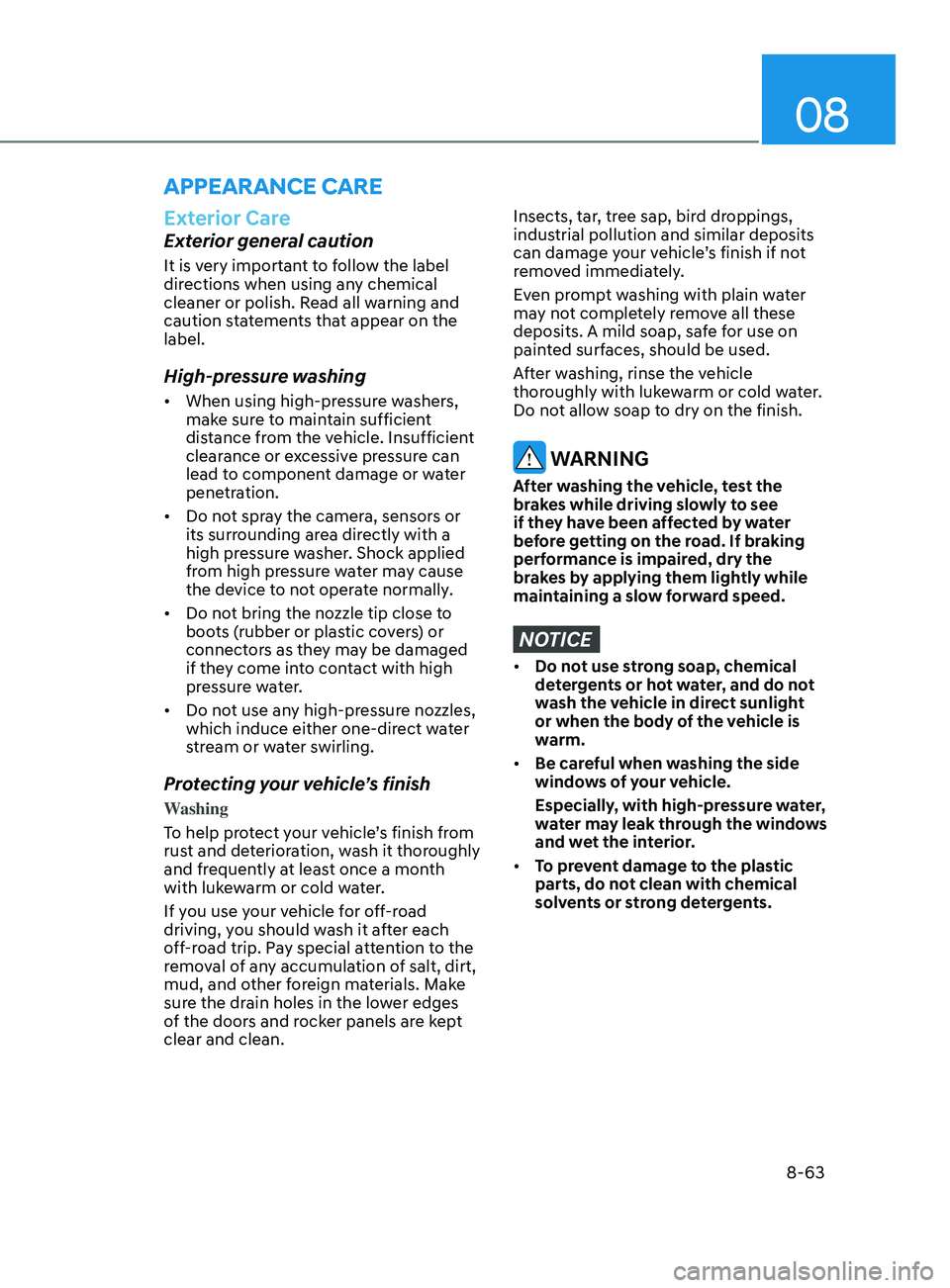
08
8-63
Exterior Care
Exterior general caution
It is very important to follow the label
directions when using any chemical
cleaner or polish. Read all warning and
caution statements that appear on the
label.
High-pressure washing
• When using high-pressure washers,
make sure to maintain sufficient
distance from the vehicle. Insufficient
clearance or excessive pressure can
lead to component damage or water
penetration.
• Do not spray the camera, sensors or
its surrounding area directly with a
high pressure washer. Shock applied
from high pressure water may cause
the device to not operate normally.
• Do not bring the nozzle tip close to
boots (rubber or plastic covers) or
connectors as they may be damaged
if they come into contact with high
pressure water.
• Do not use any high-pressure nozzles,
which induce either one-direct water
stream or water swirling.
Protecting your vehicle’s finish
Washing
To help protect your vehicle’s finish from
rust and deterioration, wash it thoroughly
and frequently at least once a month
with lukewarm or cold water.
If you use your vehicle for off-road
driving, you should wash it after each
off-road trip. Pay special attention to the
removal of any accumulation of salt, dirt,
mud, and other foreign materials. Make
sure the drain holes in the lower edges
of the doors and rocker panels are kept
clear and clean.
Insects, tar, tree sap, bird droppings,
industrial pollution and similar deposits
can damage your vehicle’s finish if not
removed immediately.
Even prompt washing with plain water
may not completely remove all these
deposits. A mild soap, safe for use on
painted surfaces, should be used.
After washing, rinse the vehicle
thoroughly with lukewarm or cold water.
Do not allow soap to dry on the finish.
WARNING
After washing the vehicle, test the
brakes while driving slowly to see
if they have been affected by water
before getting on the road. If braking
performance is impaired, dry the
brakes by applying them lightly while
maintaining a slow forward speed.
NOTICE
• Do not use strong soap, chemical
detergents or hot water, and do not
wash the vehicle in direct sunlight
or when the body of the vehicle is
warm.
• Be careful when washing the side
windows of your vehicle.
Especially, with high-pressure water,
water may leak through the windows
and wet the interior.
• To prevent damage to the plastic
parts, do not clean with chemical
solvents or strong detergents.
appEaranCE CarE
Page 519 of 546
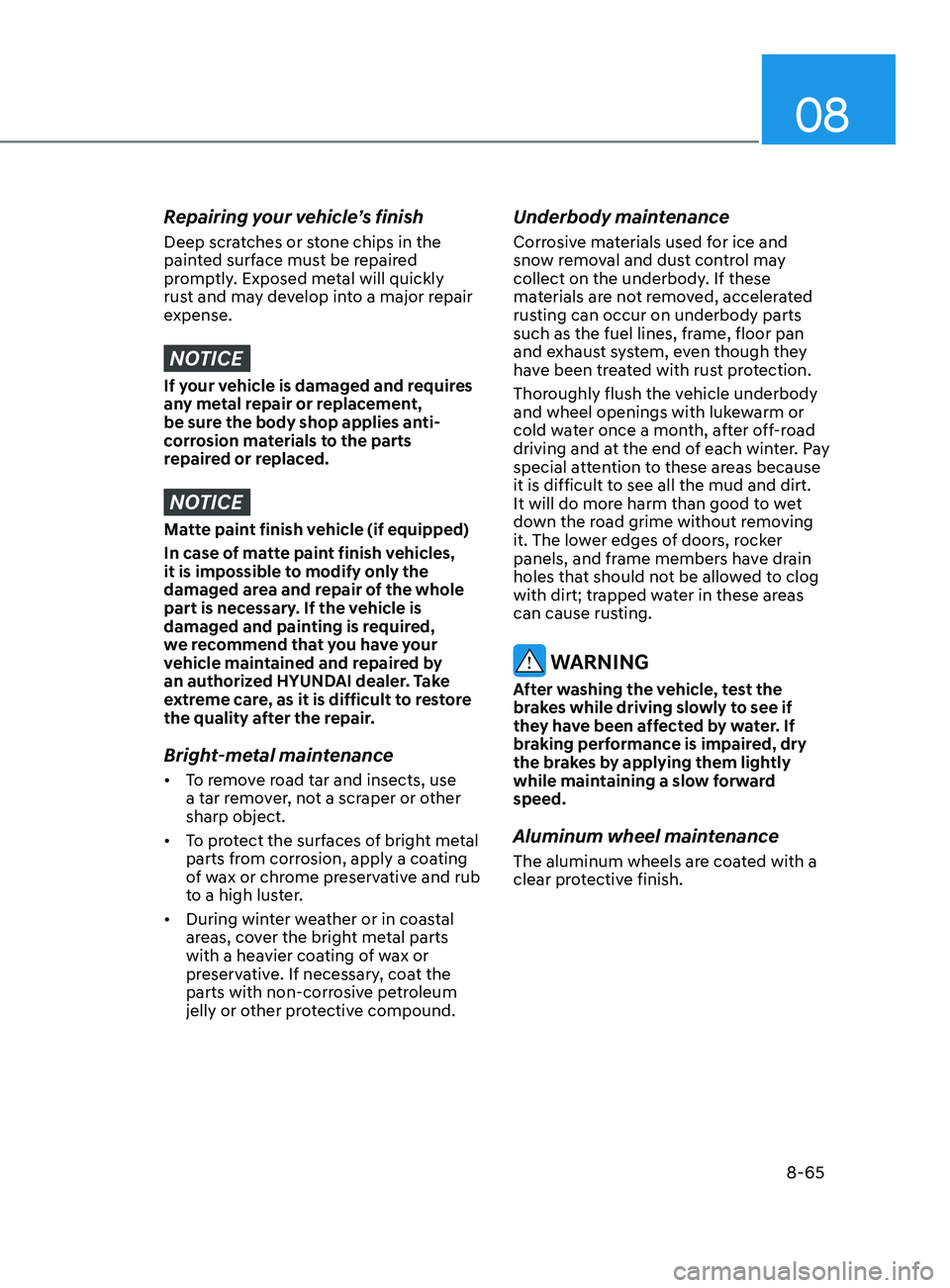
08
8-65
Repairing your vehicle’s finish
Deep scratches or stone chips in the
painted surface must be repaired
promptly. Exposed metal will quickly
rust and may develop into a major repair
expense.
NOTICE
If your vehicle is damaged and requires
any metal repair or replacement,
be sure the body shop applies anti-
corrosion materials to the parts
repaired or replaced.
NOTICE
Matte paint finish vehicle (if equipped)
In case of matte paint finish vehicles,
it is impossible to modify only the
damaged area and repair of the whole
part is necessary. If the vehicle is
damaged and painting is required,
we recommend that you have your
vehicle maintained and repaired by
an authorized HYUNDAI dealer. Take
extreme care, as it is difficult to restore
the quality after the repair.
Bright-metal maintenance
• To remove road tar and insects, use
a tar remover, not a scraper or other
sharp object.
• To protect the surfaces of bright metal
parts from corrosion, apply a coating
of wax or chrome preservative and rub
to a high luster.
• During winter weather or in coastal
areas, cover the bright metal parts
with a heavier coating of wax or
preservative. If necessary, coat the
parts with non-corrosive petroleum
jelly or other protective compound.
Underbody maintenance
Corrosive materials used for ice and
snow removal and dust control may
collect on the underbody. If these
materials are not removed, accelerated
rusting can occur on underbody parts
such as the fuel lines, frame, floor pan
and exhaust system, even though they
have been treated with rust protection.
Thoroughly flush the vehicle underbody
and wheel openings with lukewarm or
cold water once a month, after off-road
driving and at the end of each winter. Pay
special attention to these areas because
it is difficult to see all the mud and dirt.
It will do more harm than good to wet
down the road grime without removing
it. The lower edges of doors, rocker
panels, and frame members have drain
holes that should not be allowed to clog
with dirt; trapped water in these areas
can cause rusting.
WARNING
After washing the vehicle, test the
brakes while driving slowly to see if
they have been affected by water. If
braking performance is impaired, dry
the brakes by applying them lightly
while maintaining a slow forward
speed.
Aluminum wheel maintenance
The aluminum wheels are coated with a
clear protective finish.
Page 524 of 546
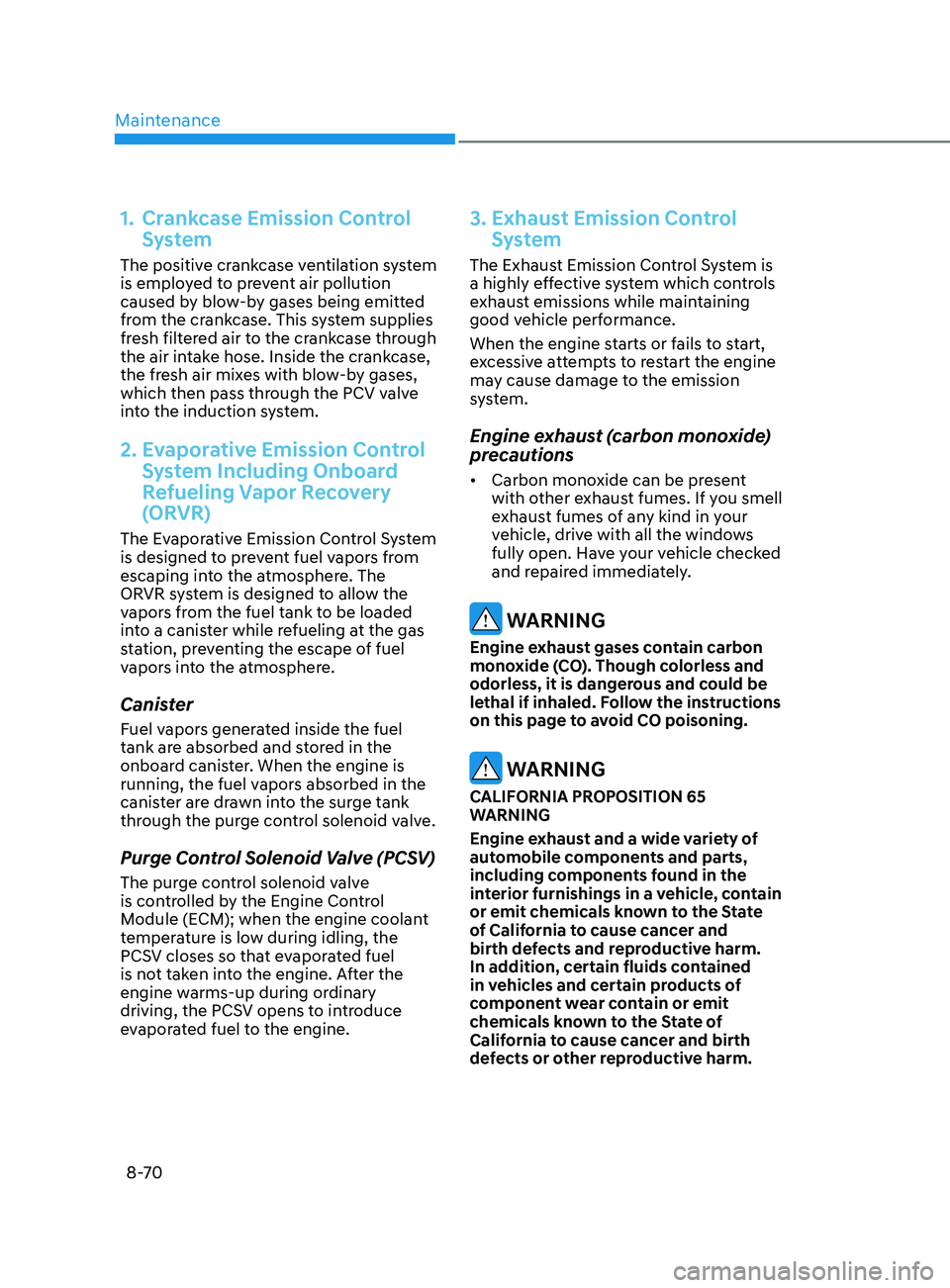
Maintenance
8-70
1. Crankcase Emission Control System
The positive crankcase ventilation system
is employed to prevent air pollution
caused by blow-by gases being emitted
from the crankcase. This system supplies
fresh filtered air to the crankcase through
the air intake hose. Inside the crankcase,
the fresh air mixes with blow-by gases,
which then pass through the PCV valve
into the induction system.
2. Evaporative Emission Control System Including Onboard
Refueling Vapor Recovery
(ORVR)
The Evaporative Emission Control System
is designed to prevent fuel vapors from
escaping into the atmosphere. The
ORVR system is designed to allow the
vapors from the fuel tank to be loaded
into a canister while refueling at the gas
station, preventing the escape of fuel
vapors into the atmosphere.
Canister
Fuel vapors generated inside the fuel
tank are absorbed and stored in the
onboard canister. When the engine is
running, the fuel vapors absorbed in the
canister are drawn into the surge tank
through the purge control solenoid valve.
Purge Control Solenoid Valve (PCSV)
The purge control solenoid valve
is controlled by the Engine Control
Module (ECM); when the engine coolant
temperature is low during idling, the
PCSV closes so that evaporated fuel
is not taken into the engine. After the
engine warms-up during ordinary
driving, the PCSV opens to introduce
evaporated fuel to the engine.
3. Exhaust Emission Control System
The Exhaust Emission Control System is
a highly effective system which controls
exhaust emissions while maintaining
good vehicle performance.
When the engine starts or fails to start,
excessive attempts to restart the engine
may cause damage to the emission
system.
Engine exhaust (carbon monoxide)
precautions
• Carbon monoxide can be present
with other exhaust fumes. If you smell
exhaust fumes of any kind in your
vehicle, drive with all the windows
fully open. Have your vehicle checked
and repaired immediately.
WARNING
Engine exhaust gases contain carbon
monoxide (CO). Though colorless and
odorless, it is dangerous and could be
lethal if inhaled. Follow the instructions
on this page to avoid CO poisoning.
WARNING
CALIFORNIA PROPOSITION 65
WARNING
Engine exhaust and a wide variety of
automobile components and parts,
including components found in the
interior furnishings in a vehicle, contain
or emit chemicals known to the State
of California to cause cancer and
birth defects and reproductive harm.
In addition, certain fluids contained
in vehicles and certain products of
component wear contain or emit
chemicals known to the State of
California to cause cancer and birth
defects or other reproductive harm.
Page 525 of 546
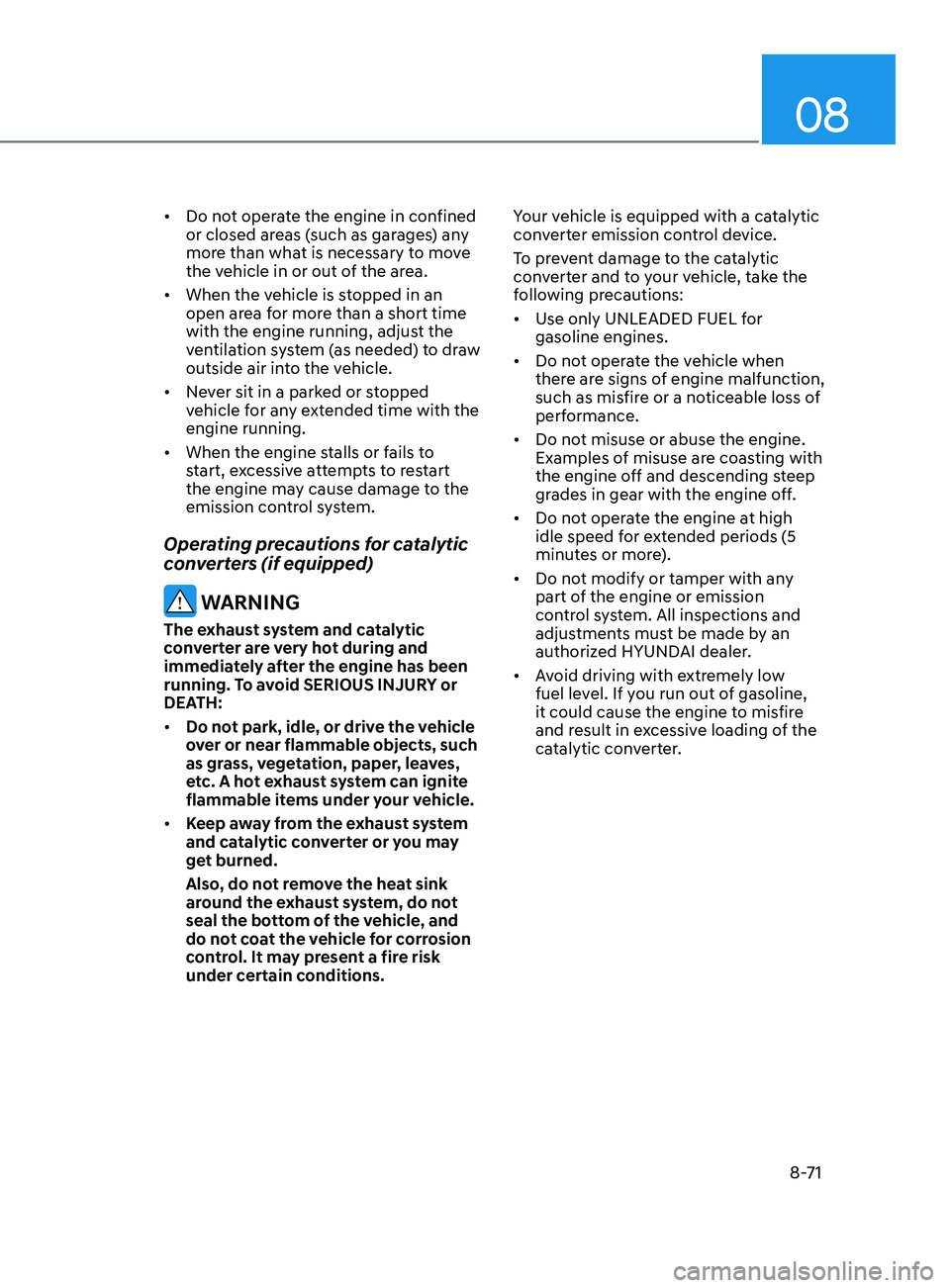
08
8-71
• Do not operate the engine in confined
or closed areas (such as garages) any
more than what is necessary to move
the vehicle in or out of the area.
• When the vehicle is stopped in an
open area for more than a short time
with the engine running, adjust the
ventilation system (as needed) to draw
outside air into the vehicle.
• Never sit in a parked or stopped
vehicle for any extended time with the
engine running.
• When the engine stalls or fails to
start, excessive attempts to restart
the engine may cause damage to the
emission control system.
Operating precautions for catalytic
converters (if equipped)
WARNING
The exhaust system and catalytic
converter are very hot during and
immediately after the engine has been
running. To avoid SERIOUS INJURY or
DEATH:
• Do not park, idle, or drive the vehicle
over or near flammable objects, such
as grass, vegetation, paper, leaves,
etc. A hot exhaust system can ignite
flammable items under your vehicle.
• Keep away from the exhaust system
and catalytic converter or you may
get burned.
Also, do not remove the heat sink
around the exhaust system, do not
seal the bottom of the vehicle, and
do not coat the vehicle for corrosion
control. It may present a fire risk
under certain conditions. Your vehicle is equipped with a catalytic
converter emission control device.
To prevent damage to the catalytic
converter and to your vehicle, take the
following precautions:
•
Use only UNLEADED FUEL for
gasoline engines.
• Do not operate the vehicle when
there are signs of engine malfunction,
such as misfire or a noticeable loss of
performance.
• Do not misuse or abuse the engine.
Examples of misuse are coasting with
the engine off and descending steep
grades in gear with the engine off.
• Do not operate the engine at high
idle speed for extended periods (5
minutes or more).
• Do not modify or tamper with any
part of the engine or emission
control system. All inspections and
adjustments must be made by an
authorized HYUNDAI dealer.
• Avoid driving with extremely low
fuel level. If you run out of gasoline,
it could cause the engine to misfire
and result in excessive loading of the
catalytic converter.
Page 527 of 546
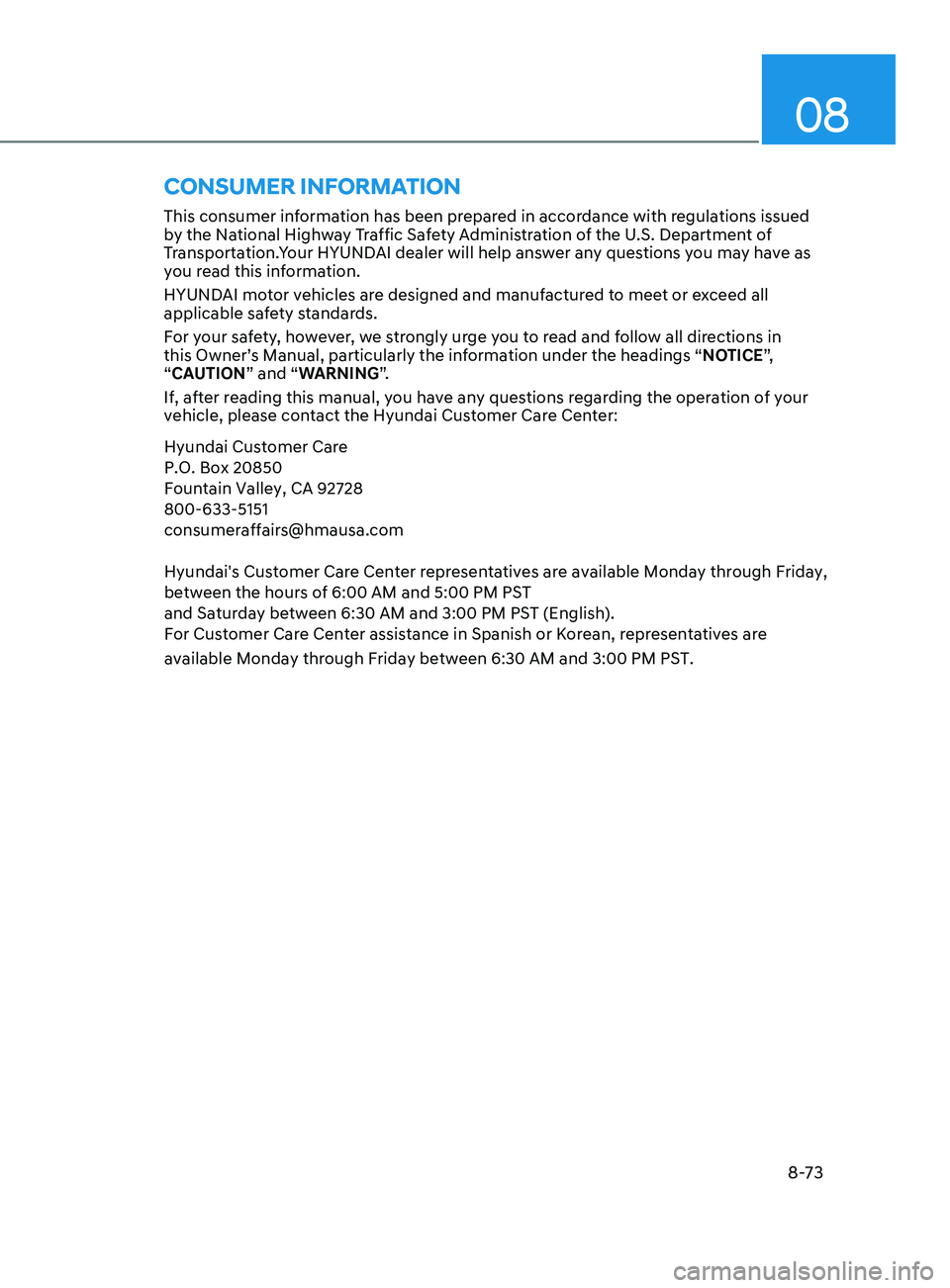
08
8-73
ConSumEr information
This consumer information has been prepared in accordance with regulations issued
by the National Highway Traffic Safety Administration of the U.S. Department of
Transportation.Your HYUNDAI dealer will help answer any questions you may have as
you read this information.
HYUNDAI motor vehicles are designed and manufactured to meet or exceed all
applicable safety standards.
For your safety, however, we strongly urge you to read and follow all directions in
this Owner’s Manual, particularly the information under the headings “NOTICE”,
“CAUTION” and “WARNING”.If, after reading this manual, you have any questions regarding the oper\
ation of your
vehicle, please contact the Hyundai Customer Care Center:
Hyundai Customer Care
P.O. Box 20850
Fountain Valley, CA 92728
800-633-5151
[email protected]
Hyundai's Customer Care Center representatives are available Monday through Friday,
between the hours of 6:00 AM and 5:00 PM PST
and Saturday between 6:30 AM and 3:00 PM PST (English).
For Customer Care Center assistance in Spanish or Korean, representatives are
available Monday through Friday between 6:30 AM and 3:00 PM PST.
Page 530 of 546
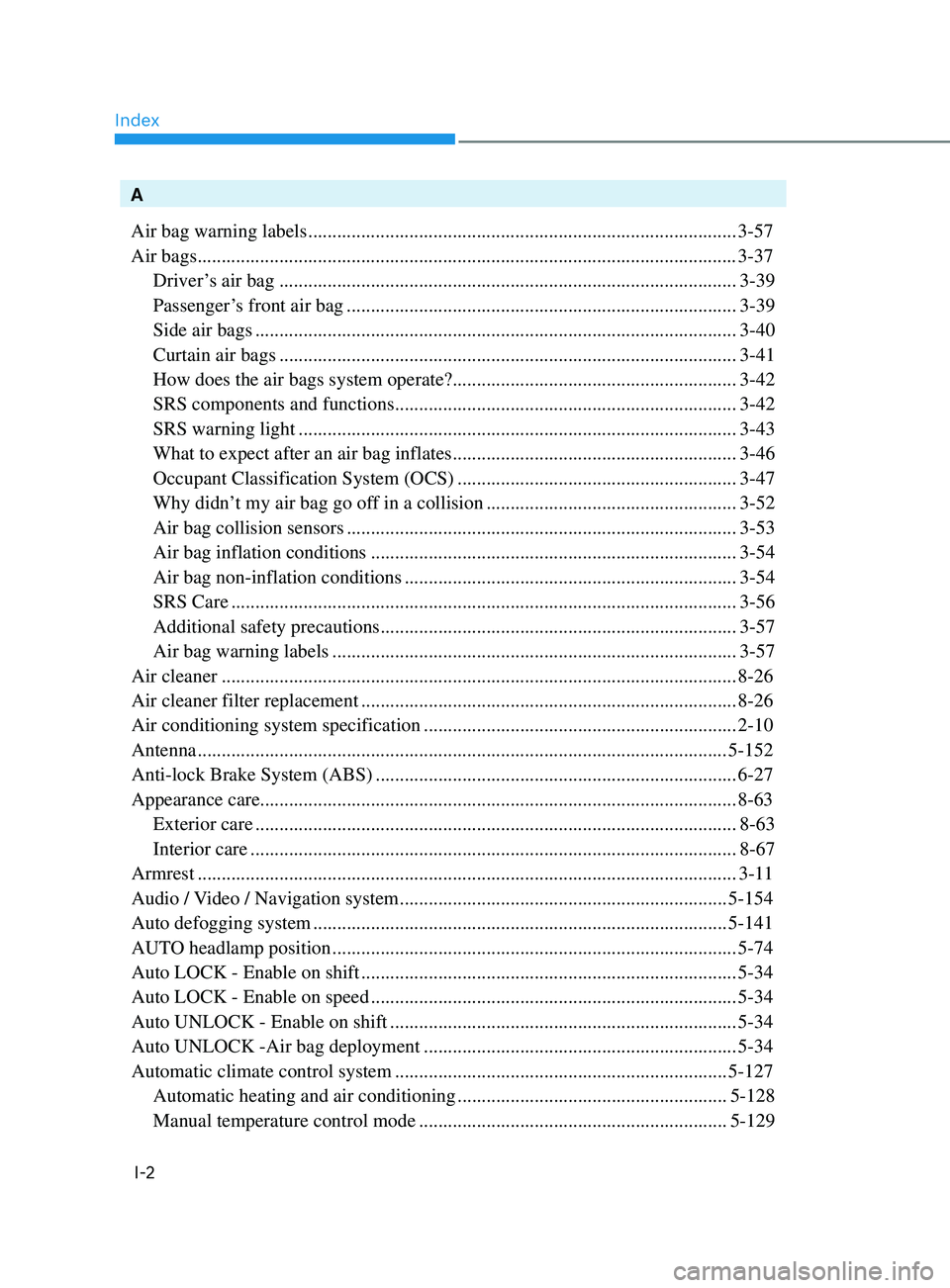
Index
I-2
A
Air bag warning labels
........................................................................\
................. 3-57
Air bags
........................................................................\
........................................ 3-37
Driver’s air bag
........................................................................\
....................... 3-39
Passenger’s front air bag
........................................................................\
......... 3-39
Side air bags
........................................................................\
............................ 3-40
Curtain air bags
........................................................................\
....................... 3-41
How does the air bags system operate?........................................................... 3-42
SRS components and functions
....................................................................... 3-42
SRS warning light
........................................................................\
................... 3-43
What to expect after an air bag inflates
...........................................................3-46
Occupant Classification System (OCS)
.......................................................... 3-47
Why didn’
t my air bag go off in a collision
....................................................3-52
Air bag collision sensors
........................................................................\
......... 3-53
Air bag inflation conditions
........................................................................\
.... 3-54
Air bag non-inflation conditions
..................................................................... 3-54
SRS Care
........................................................................\
................................. 3-56
Additional safety precautions
........................................................................\
.. 3-57
Air bag warning labels
........................................................................\
............ 3-57
Air cleaner
........................................................................\
................................... 8-26
Air cleaner filter replacement
........................................................................\
...... 8-26
Air conditioning system specification
................................................................. 2-10
Antenna
........................................................................\
...................................... 5-152
Anti-lock Brake System (ABS)
........................................................................\
... 6-27
Appearance care........................................................................\
........................... 8-63 Exterior care
........................................................................\
............................ 8-63
Interior care
........................................................................\
............................. 8-67
Armrest
........................................................................\
........................................ 3-11
Audio / Video / Navigation system
.................................................................... 5-154
Auto defogging system
........................................................................\
.............. 5-141
AUT
O headlamp position
........................................................................\
............ 5-74
Auto LOCK - Enable on shift
........................................................................\
...... 5-34
Auto LOCK - Enable on speed
........................................................................\
.... 5-34
Auto UNLOCK - Enable on shift
........................................................................\
5-34
Auto UNLOCK -Air bag deployment
................................................................. 5-34
Automatic climate control system
..................................................................... 5-127
Automatic heating and air conditioning
........................................................5-128
Manual temperature control mode
................................................................ 5-129
Page 531 of 546
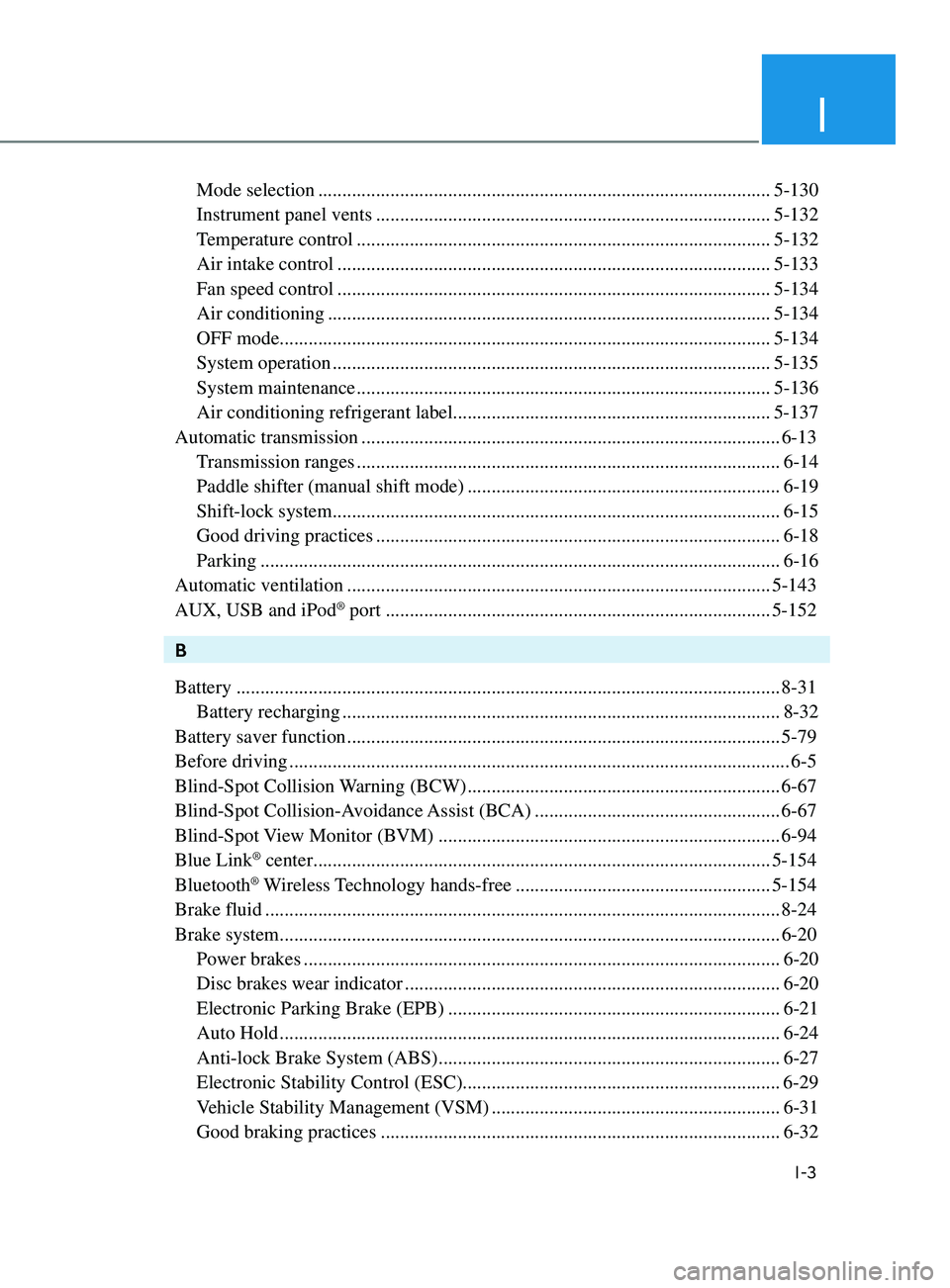
I
I-3
Mode selection ........................................................................\
...................... 5-130
Instrument panel vents
........................................................................\
.......... 5-132
Temperature control
........................................................................\
.............. 5-132
Air intake control
........................................................................\
.................. 5-133
Fan speed control
........................................................................\
.................. 5-134
Air conditioning
........................................................................\
.................... 5-134
OFF mode........................................................................\
.............................. 5-134
System operation
........................................................................\
................... 5-135
System maintenance
........................................................................\
.............. 5-136
Air conditioning refrigerant label.................................................................. 5-137
Automatic transmission
........................................................................\
............... 6-13
Transmission ranges
........................................................................\
................ 6-14
Paddle shifter (manual shift mode)
................................................................. 6-19
Shift-lock system
........................................................................\
..................... 6-15
Good driving practices
........................................................................\
............ 6-18
Parking
........................................................................\
.................................... 6-16
Automatic ventilation
........................................................................\
................ 5-143
AUX, USB and iPod
® port ........................................................................\
........ 5-152
B
Battery
........................................................................\
......................................... 8-31
Battery recharging
........................................................................\
................... 8-32
Battery saver function
........................................................................\
.................. 5-79
Before driving
........................................................................\
................................ 6-5
Blind-Spot Collision Warning (BCW)
................................................................. 6-67
Blind-Spot Collision-Avoidance Assist (BCA)
................................................... 6-67
Blind-Spot View Monitor (BVM)
....................................................................... 6-94
Blue Link
® center ........................................................................\
....................... 5-154
Bluetooth® Wireless Technology hands-free ..................................................... 5-154
Brake fluid
........................................................................\
................................... 8-24
Brake system
........................................................................\
................................ 6-20
Power brakes
........................................................................\
........................... 6-20
Disc brakes wear indicator
........................................................................\
...... 6-20
Electronic Parking Brake (EPB)
..................................................................... 6-21
Auto Hold
........................................................................\
................................ 6-24
Anti-lock Brake System (ABS)
....................................................................... 6-27
Electronic Stability Control (ESC).................................................................. 6-29
Vehicle Stability Management (VSM)
............................................................ 6-31
Good braking practices
........................................................................\
........... 6-32